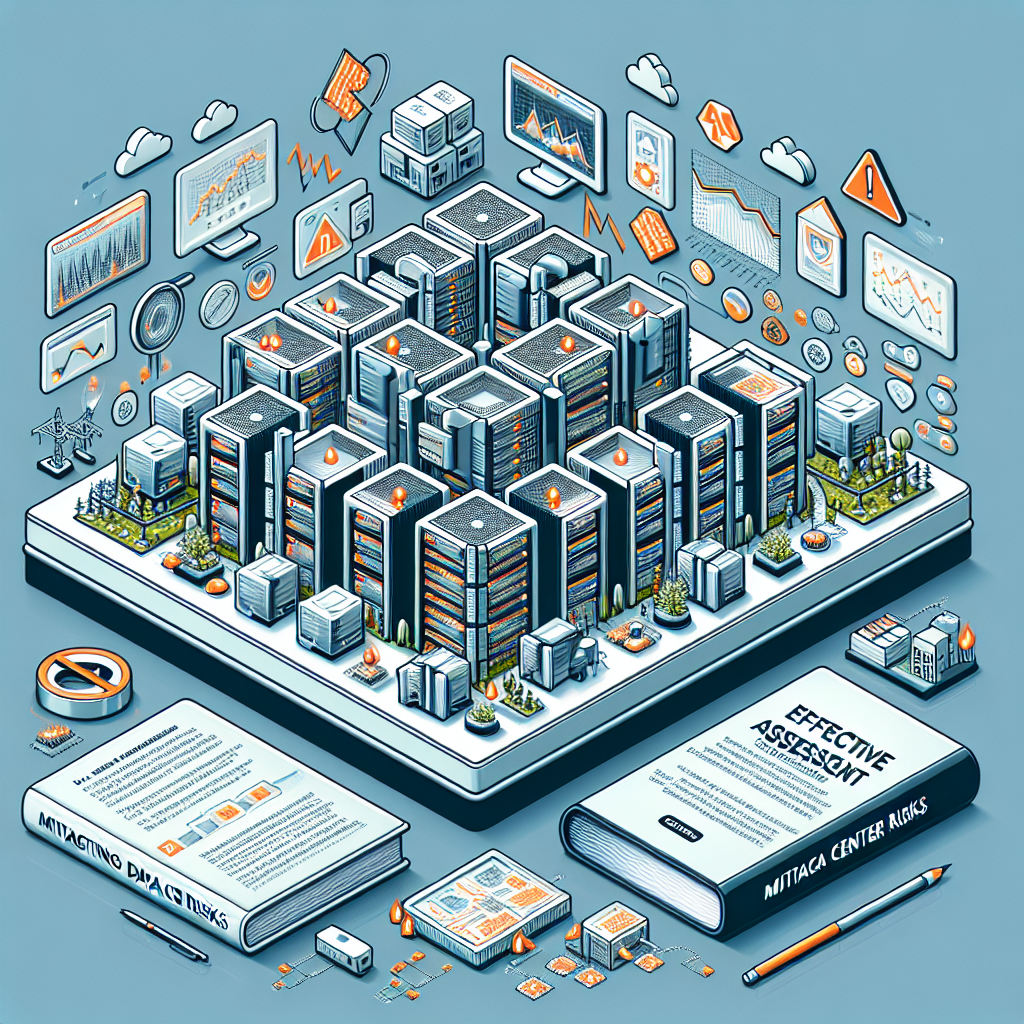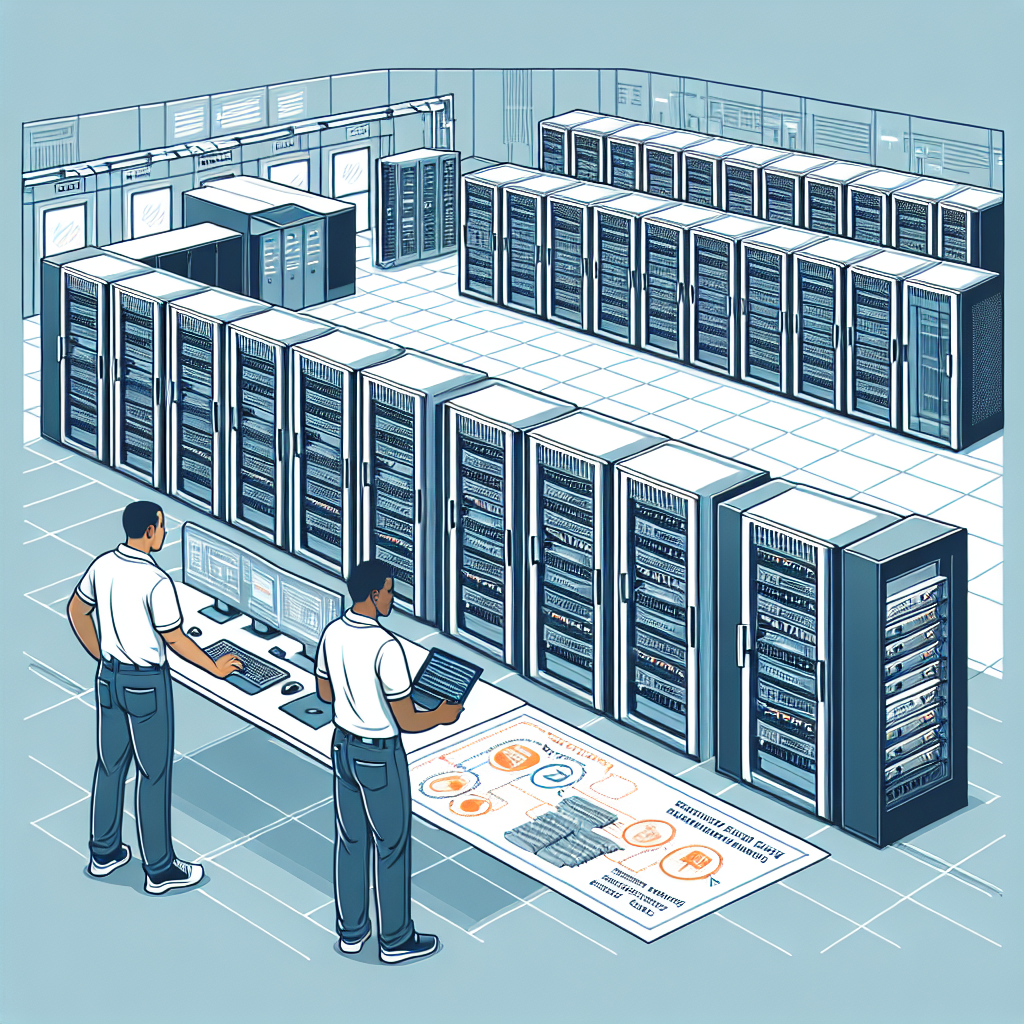Your cart is currently empty!
Tag: Comprehensive

Mitigating Data Center Risks: A Comprehensive Guide to Effective Assessment
Data centers play a crucial role in the smooth operation of businesses, housing vital information and infrastructure that support day-to-day operations. However, data centers are not immune to risks, and any disruption can have catastrophic consequences for a business. It is essential for organizations to conduct a comprehensive assessment of data center risks and implement effective mitigation strategies to ensure business continuity.Identifying and assessing risks is the first step in mitigating data center risks. This involves conducting a thorough examination of all potential threats that could impact the data center, including natural disasters, cyber attacks, equipment failures, and human errors. A risk assessment should also consider the potential impact of these threats on the business, such as financial losses, reputational damage, and legal implications.
Once risks have been identified, organizations can develop a comprehensive risk mitigation strategy. This involves implementing a range of measures to reduce the likelihood of a risk occurring and minimize its impact if it does. Some key risk mitigation strategies include:
1. Implementing robust security measures: Data centers are prime targets for cyber attacks, so it is crucial to implement robust security measures to protect sensitive information. This includes using firewalls, encryption, and access controls to prevent unauthorized access to data.
2. Maintaining backup and redundancy: To mitigate the risk of data loss due to equipment failure or natural disasters, organizations should maintain regular backups of critical data and implement redundancy measures to ensure data can be quickly restored in the event of an outage.
3. Conducting regular maintenance and testing: Regular maintenance and testing of data center equipment and systems are essential to identify and address potential issues before they escalate into serious problems.
4. Training and education: Human error is a common cause of data center disruptions, so organizations should provide comprehensive training and education to staff on data center best practices and security protocols.
5. Developing a comprehensive disaster recovery plan: In the event of a major data center disruption, a comprehensive disaster recovery plan can help organizations quickly recover and resume operations. This plan should outline key roles and responsibilities, as well as the steps to be taken to restore data and infrastructure.
By conducting a comprehensive assessment of data center risks and implementing effective mitigation strategies, organizations can minimize the likelihood of disruptions and ensure business continuity. Mitigating data center risks requires a proactive approach, with a focus on prevention and preparedness. By investing in robust security measures, regular maintenance, and disaster recovery planning, organizations can protect their data centers and safeguard their business operations.

Understanding Data Center Cabling: A Comprehensive Guide for IT Professionals
In today’s digital age, data centers play a crucial role in storing, processing, and managing vast amounts of information for businesses and organizations. The cabling infrastructure in these data centers is a critical component that ensures data is transmitted efficiently and reliably. Understanding data center cabling is essential for IT professionals to optimize performance and maintain uptime.Data center cabling refers to the network of cables and connectors that connect servers, storage devices, networking equipment, and other hardware within a data center. The cabling infrastructure is responsible for carrying data between devices, ensuring communication between different components, and providing power to devices.
There are several key factors to consider when designing and implementing data center cabling. These include the type of cables and connectors used, cable management, cable routing, and cable labeling. IT professionals must also consider factors such as data transmission speeds, compatibility with existing equipment, and future scalability when choosing cabling solutions.
When it comes to data center cabling, there are several types of cables and connectors to choose from. Some of the most common types include:
– Copper cables: Copper cables are widely used in data centers for their affordability and reliability. They are suitable for short-distance connections and support data transmission speeds of up to 10 Gbps.
– Fiber optic cables: Fiber optic cables are ideal for long-distance connections and high-speed data transmission. They are more expensive than copper cables but offer greater bandwidth and faster data transfer speeds.
– Ethernet cables: Ethernet cables are commonly used for connecting networking equipment within a data center. They come in various categories, such as Cat5e, Cat6, and Cat7, each offering different data transmission speeds and performance.
Proper cable management is crucial in data centers to ensure cables are organized, secure, and easily accessible for maintenance and troubleshooting. IT professionals should use cable trays, racks, and cable ties to keep cables organized and prevent tangling. Proper cable routing is also essential to ensure cables are not bent or twisted, which can cause signal interference and data loss.
In addition to cable management and routing, IT professionals should also label cables to easily identify connections and troubleshoot issues. Labeling cables with unique identifiers can save time and effort when tracing cables and making changes to the cabling infrastructure.
Understanding data center cabling is essential for IT professionals to ensure optimal performance, reliability, and scalability of data center infrastructure. By choosing the right cables and connectors, implementing proper cable management and routing practices, and labeling cables effectively, IT professionals can build a robust cabling infrastructure that meets the demands of today’s data centers.

How to Develop a Comprehensive Data Center Preventative Maintenance Plan
A data center is the heart of any organization’s IT infrastructure, housing critical systems and equipment that are essential for the operation of the business. To ensure the smooth functioning of a data center and prevent costly downtime, it is crucial to have a comprehensive preventative maintenance plan in place. Here are some key steps to develop a robust maintenance plan for your data center:1. Conduct a thorough assessment: Before developing a maintenance plan, it is important to conduct a comprehensive assessment of your data center. This includes identifying all the critical systems and equipment, assessing their current condition, and determining their maintenance requirements.
2. Identify maintenance tasks: Once you have identified the critical systems and equipment in your data center, the next step is to determine the maintenance tasks that need to be performed on a regular basis. This includes tasks such as inspecting equipment for signs of wear and tear, cleaning air filters, checking for overheating, and testing backup systems.
3. Establish a schedule: It is important to establish a regular maintenance schedule for your data center to ensure that all maintenance tasks are performed in a timely manner. This schedule should be based on the manufacturer’s recommendations, industry best practices, and the specific needs of your data center.
4. Assign responsibilities: Clearly define roles and responsibilities for each maintenance task and assign them to qualified personnel. Make sure that all staff members are trained on how to perform maintenance tasks safely and effectively.
5. Document procedures: Document all maintenance procedures in a detailed maintenance plan that includes step-by-step instructions, checklists, and guidelines for troubleshooting common issues. This will help ensure consistency and efficiency in performing maintenance tasks.
6. Monitor performance: Regularly monitor the performance of your data center systems and equipment to identify any potential issues before they escalate into major problems. Use monitoring tools and software to track key performance metrics and set up alerts for any abnormal behavior.
7. Review and update the plan: Regularly review and update your preventative maintenance plan to reflect changes in equipment, technology, and best practices. Make sure to incorporate feedback from staff members and learn from past maintenance incidents to continuously improve the plan.
By following these steps and developing a comprehensive preventative maintenance plan for your data center, you can ensure the reliability and efficiency of your IT infrastructure and minimize the risk of costly downtime. Remember that prevention is always better than cure, and investing in proactive maintenance can save you time, money, and headaches in the long run.

Mastering Data Center Operations: A Comprehensive Training Guide
Data centers are the backbone of modern businesses, providing the infrastructure necessary to store, manage, and process vast amounts of data. As the demand for data center services continues to grow, the need for skilled professionals who can effectively manage and operate these facilities has never been greater. For those looking to enter this dynamic field or advance their career in data center operations, mastering the necessary skills and knowledge is essential.To help professionals navigate the complex world of data center operations, a comprehensive training guide has been developed to provide a roadmap for mastering the key concepts and best practices in this field. This guide covers everything from the basics of data center design and maintenance to advanced topics such as virtualization, cloud computing, and security.
One of the first steps in mastering data center operations is understanding the fundamental principles of data center design and layout. This includes learning about the different types of data centers, their components, and how they are organized to optimize performance and efficiency. By gaining a solid foundation in data center design, professionals can better understand how to troubleshoot issues, plan for future growth, and ensure the overall stability and reliability of the facility.
Once the basics of data center design are mastered, professionals can then move on to more advanced topics such as virtualization and cloud computing. Virtualization allows data center operators to maximize the use of their resources by creating virtual machines that can run multiple operating systems and applications on a single physical server. Cloud computing, on the other hand, enables businesses to access and store data and applications over the internet, eliminating the need for on-site servers and storage.
In addition to technical skills, data center operators must also be well-versed in security best practices to protect sensitive data and ensure the integrity of the facility. This includes implementing access controls, monitoring for suspicious activity, and regularly updating security protocols to defend against cyber threats.
To help professionals acquire the necessary skills and knowledge to excel in data center operations, a comprehensive training guide has been developed that covers all aspects of data center management. From basic principles to advanced topics, this guide provides a comprehensive overview of the key concepts and best practices in data center operations.
By mastering the skills and knowledge outlined in this training guide, professionals can position themselves for success in the fast-paced and ever-evolving field of data center operations. Whether you are just starting out in your career or looking to advance to a more senior role, this guide can help you build a strong foundation and achieve your goals in data center management.

The Importance of Change Management in Data Centers: A Comprehensive Guide
Data centers are the backbone of any organization’s IT infrastructure, housing and managing critical data and applications that are essential for business operations. As technology continues to evolve at a rapid pace, data centers must also adapt to keep up with the changing demands of the digital landscape. This is where change management comes in.Change management is a systematic approach to dealing with the transition or transformation of an organization’s processes, technology, or services. In the context of data centers, change management is crucial for ensuring that any changes made to the infrastructure are implemented smoothly and efficiently, with minimal disruption to operations.
There are several key reasons why change management is important in data centers:
1. Minimizing downtime: Any changes made to the data center, whether it’s upgrading hardware, installing new software, or reconfiguring networks, have the potential to disrupt operations and cause downtime. Change management helps to minimize this risk by carefully planning and coordinating changes to ensure that they are implemented in a controlled and organized manner.
2. Preventing errors: Data centers are complex environments with numerous interconnected systems and components. Without proper change management processes in place, there is a greater risk of errors occurring during changes, which can lead to data loss, security breaches, and other serious consequences. Change management helps to mitigate this risk by providing a structured framework for reviewing, testing, and validating changes before they are implemented.
3. Ensuring compliance: Data centers are subject to various regulatory requirements and industry standards, such as GDPR, HIPAA, and PCI DSS. Change management plays a crucial role in ensuring that changes made to the data center comply with these standards and regulations, reducing the risk of non-compliance and potential legal consequences.
4. Enhancing security: Cybersecurity threats are a constant concern for data centers, as they are a prime target for hackers seeking to steal sensitive data or disrupt operations. Change management helps to enhance security by implementing best practices for managing changes, such as access controls, encryption, and monitoring, to prevent unauthorized access and protect against cyber threats.
5. Improving efficiency: By having a structured approach to managing changes, data centers can improve operational efficiency and reduce the time and resources required to implement changes. Change management helps to streamline processes, eliminate redundancies, and optimize workflows, leading to a more agile and responsive data center environment.
In conclusion, change management is a critical component of effective data center management, helping organizations to adapt to the evolving technology landscape while minimizing risks and maximizing efficiency. By implementing robust change management processes, data centers can ensure that changes are implemented smoothly, securely, and in compliance with regulatory requirements, ultimately enhancing the resilience and reliability of their IT infrastructure.

A Comprehensive Guide to Data Center Monitoring Tools and Best Practices
Data centers are the backbone of modern businesses, housing critical IT infrastructure and applications that are essential for operations. Monitoring the performance and health of data centers is crucial to ensure smooth operations and prevent downtime. With the increasing complexity of data centers and the growing volume of data being processed, having the right monitoring tools and best practices in place is essential.Data center monitoring tools are software solutions that allow IT administrators to keep a close eye on the performance, availability, and security of the data center infrastructure. These tools provide real-time visibility into key metrics such as server health, network traffic, storage capacity, and application performance. With the right monitoring tools in place, IT teams can proactively identify and address issues before they impact business operations.
There are many data center monitoring tools available on the market, each offering a unique set of features and capabilities. Some popular tools include Nagios, Zabbix, SolarWinds, and PRTG Network Monitor. These tools offer a range of monitoring capabilities, from simple server monitoring to more advanced network and application monitoring.
When selecting a data center monitoring tool, it’s important to consider the specific needs and requirements of your organization. Some key factors to consider include scalability, ease of use, integration with existing systems, and cost. It’s also important to ensure that the monitoring tool provides comprehensive coverage of all aspects of the data center infrastructure, including servers, storage, networking, and applications.
In addition to selecting the right monitoring tool, it’s also important to establish best practices for data center monitoring. Some key best practices include:
1. Define monitoring objectives: Before implementing a monitoring tool, it’s important to clearly define the objectives and goals of data center monitoring. This will help ensure that the monitoring tool is aligned with the organization’s overall IT strategy.
2. Monitor key metrics: Identify the key performance indicators (KPIs) that are critical to the operation of the data center, such as server uptime, network latency, and application response time. Monitoring these metrics will help IT teams quickly identify and address issues.
3. Set up alerts and notifications: Configure the monitoring tool to send alerts and notifications when a predefined threshold is exceeded. This will help IT teams proactively address issues before they impact business operations.
4. Regularly review and analyze data: Regularly review monitoring data to identify trends and patterns that may indicate potential issues. Analyzing this data will help IT teams make informed decisions and optimize the performance of the data center infrastructure.
5. Implement a disaster recovery plan: In the event of a data center outage or failure, it’s important to have a comprehensive disaster recovery plan in place. This plan should outline the steps to take to restore operations and minimize downtime.
By implementing the right data center monitoring tools and following best practices, organizations can ensure the performance, availability, and security of their data center infrastructure. With real-time visibility into key metrics and proactive monitoring, IT teams can quickly identify and address issues, ultimately improving the overall reliability and efficiency of the data center.

Best Practices for Data Center Incident Management: A Comprehensive Guide
Data centers are the backbone of modern businesses, housing critical IT infrastructure and sensitive data. With the increasing frequency and complexity of cyber threats, it is crucial for data center operators to have a robust incident management plan in place to effectively respond to and recover from security incidents. In this comprehensive guide, we will discuss the best practices for data center incident management to help organizations minimize downtime, protect their data, and maintain business continuity.1. Establish an Incident Response Team: The first step in effective incident management is to establish a dedicated incident response team. This team should consist of individuals with expertise in IT security, network operations, and data center management. The team should be well-trained and equipped to respond quickly and effectively to security incidents.
2. Develop an Incident Response Plan: A comprehensive incident response plan is essential for data center operators to effectively manage security incidents. The plan should outline the steps to be taken in the event of a security incident, including detection, containment, eradication, recovery, and post-incident analysis. The plan should be regularly reviewed and updated to ensure it remains relevant and effective.
3. Implement Monitoring and Detection Systems: Proactive monitoring and detection systems are essential for identifying security incidents in real-time. Data center operators should implement intrusion detection systems, log monitoring tools, and security information and event management (SIEM) solutions to monitor network traffic and detect potential threats.
4. Conduct Regular Security Audits and Assessments: Regular security audits and assessments are essential for identifying vulnerabilities and weaknesses in the data center infrastructure. Data center operators should conduct penetration testing, vulnerability scanning, and security assessments to identify potential security risks and address them before they are exploited by malicious actors.
5. Define Incident Severity Levels: Incident severity levels help data center operators prioritize and respond to security incidents based on their impact on the business. By defining severity levels, organizations can ensure that critical incidents are addressed promptly and effectively, while less severe incidents are managed in a timely manner.
6. Collaborate with External Partners: In the event of a security incident, data center operators may need to collaborate with external partners, such as law enforcement agencies, cybersecurity experts, and forensic investigators. Establishing relationships with external partners in advance can help streamline the incident response process and ensure a coordinated and effective response.
7. Conduct Post-Incident Analysis: After a security incident has been resolved, it is essential to conduct a post-incident analysis to identify the root cause of the incident, assess the effectiveness of the response, and implement measures to prevent similar incidents in the future. Data center operators should document lessons learned and incorporate them into their incident response plan.
In conclusion, effective data center incident management is essential for ensuring the security and resilience of critical IT infrastructure. By following the best practices outlined in this guide, data center operators can minimize downtime, protect their data, and maintain business continuity in the face of security incidents. Remember, preparation is key to effective incident management – so take the time to develop a comprehensive incident response plan and train your team to respond quickly and effectively to security incidents.

The Importance of Comprehensive Data Center Documentation
Data centers play a crucial role in today’s digital landscape, serving as the backbone of organizations’ IT infrastructure. With the increasing amount of data being generated and processed, data centers need to be efficient, reliable, and scalable. One key aspect of ensuring the smooth operation of a data center is comprehensive documentation.Documentation is often overlooked or not given enough importance in data center management. However, it is a critical component that can help data center operators and IT professionals in various ways. Here are some reasons why comprehensive data center documentation is important:
1. Disaster Recovery and Business Continuity: In the event of a disaster or outage, having detailed documentation of the data center infrastructure, equipment, configurations, and processes can help in quickly restoring operations. This can minimize downtime and ensure business continuity.
2. Efficient Troubleshooting: Comprehensive documentation can assist in troubleshooting issues and identifying root causes faster. It provides a reference point for IT staff to understand the data center setup, connections, and configurations, enabling them to resolve issues more effectively.
3. Compliance and Auditing: Data centers are subject to various regulations and compliance requirements, such as GDPR, HIPAA, and PCI DSS. Detailed documentation can help in demonstrating compliance with these regulations and passing audits smoothly.
4. Capacity Planning and Resource Management: Documentation of hardware, software, and network configurations can aid in capacity planning and resource management. It helps in identifying underutilized resources, optimizing performance, and planning for future expansion.
5. Training and Knowledge Transfer: Comprehensive documentation is invaluable for training new staff and transferring knowledge within the organization. It provides a reference for employees to understand the data center environment and processes, ensuring continuity in operations.
6. Security and Access Control: Documentation of security measures, access controls, and permissions is essential for ensuring data center security. It helps in identifying vulnerabilities, implementing security best practices, and monitoring access to sensitive data.
In conclusion, comprehensive data center documentation is essential for the efficient and effective management of data center operations. It helps in disaster recovery, troubleshooting, compliance, capacity planning, training, security, and more. Investing time and resources in documenting the data center infrastructure and processes can pay off in terms of improved operational efficiency, reduced downtime, and enhanced security. Data center operators and IT professionals should prioritize documentation as a critical aspect of data center management.
